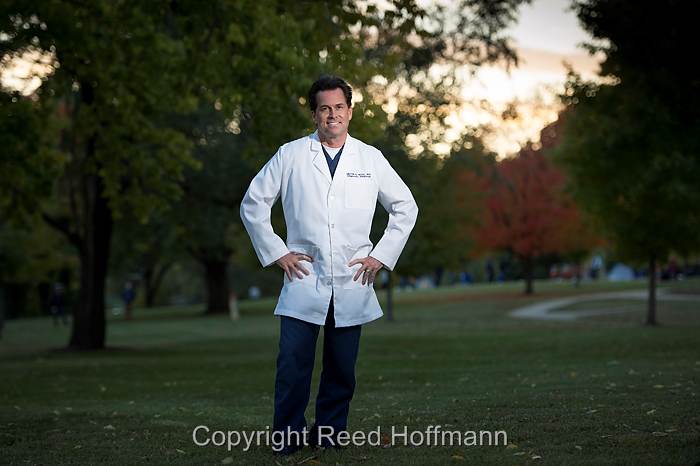Last month I had a call from the London Times to ask if I could help with an assignment in Kansas City. They were profiling a local political figure, and wanted me to meet their reporter and provide pictures. The time and price worked for me, so I said, “sure, give me the details.” And, as with many assignments, what we’d planned and what happened were very different. That’s one of the key skills you learn as a photojournalist – how to adapt quickly to change.
I had imagined spending the day, or at least a few hours, following the subject around. Perhaps doing some photos of him at work (he’s a doctor) and/or following him on his daily routine. Maybe as he did some political work. The paper wanted more than just a mug shot or what we call “talking heads” (interview shots). As it turned out, what they offered us was 30-minutes at a coffee shop.
Hoping I’d be able to talk him into doing some pictures outside, I arrived early and scouted the area. There was a park with nice grass and trees about five-minutes away. And if I had to, there were some places just outside the coffee shop that might work.
Meeting the reporter early, we discussed what we’d do if we could talk him into more time. Perhaps an hour? When he and his press aide arrived, we did introductions and then asked if we could get more time. Forty-five minutes was the max, they said. The writer had already told me that he only needed about thirty-minutes for the interview, so that would give me fifteen-minutes to do some portraits.
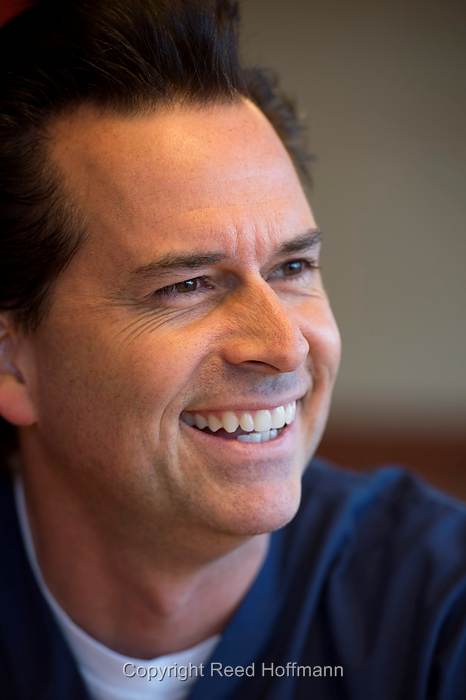
For the tight shots I did both vertical and horizontal, and looked for both smiling and series expressions. Nikon D4, ISO of 1000, shutter speed 1/250 at f/4, with exposure compensation at -0.3. 70-200mm f/2.8 lens. Photo copyright Reed Hoffmann.
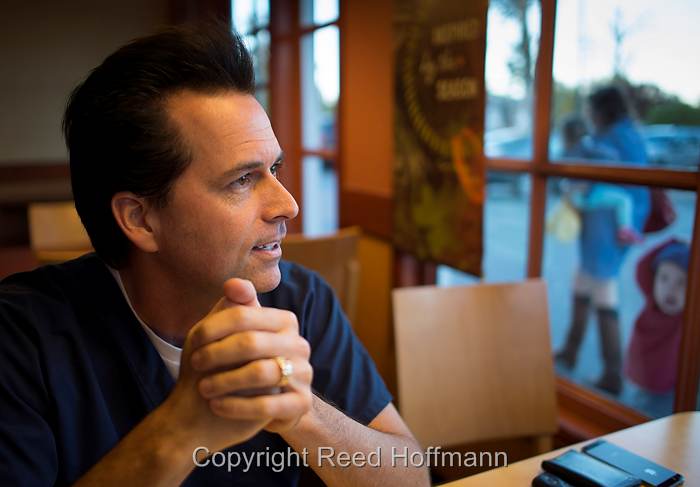
To get a different feeling, I used a wide lens close to add some intimacy and a feeling of location. Nikon D4, ISO of 400, shutter speed 1/400 at f/1.8, with exposure compensation at -0.7. 28mm f/1.8 lens. Photo copyright Reed Hoffmann.
For the interview I asked the candidate to sit in a spot where I could shoot tight pictures of his face with a clean background, using a mix of daylight (from windows next to him) and the overhead incandescent lights. I asked the reporter to sit across from him at an angle, so I’d have a good position to shoot from.
Because of the mix of light, I did a white balance preset (sometimes called a “custom” white balance) off a gray card in the light he was in. That would take that mix of daylight and incandescent and neutralize them, processing that mix as white light to look natural.
To make sure I wouldn’t get blur while he was talking, I needed a relatively fast shutter speed. ISO 1000 let me shoot 1/250 at f/4, which also gave me a bit of depth of field so his entire face would be sharp (not just one of his eyes). That was still wide enough of an aperture to keep the background out of focus. For the first shots I used a 70-200mm f/2.8 lens. Then I moved in close with a 28mm f/1.8 for a wider shot, but still used a wide aperture to keep the focus on him and not the background.
The interview started at 5:30pm and ended right at 6pm, as promised. I immediately herded everyone to my car and drove to that nearby park. Most of the light was gone, ajdnd the sun was setting, so my plan was to shoot him against that remaining light, and add flash to “pop” him out. I already had my gear ready for that. In the back of my car there was a seven-foot light stand with a Nikon SB-910 speedlight attached. On the front of the flash I’d attached a small Rogue Grid (a simple accessory made by ExpoImaging), which would give me a spotlight effect. Finally, the flash was set for “Remote,” so I could trigger it from the camera (a Nikon F4) using an SU-800 Commander.
When we reached the park I grabbed my gear and the light stand and took the candidate up near the trees. As the reporter continued to talk with him I found a background that worked and set up the light. Keeping in mind the 6:15pm deadline, I had him step in, shot a couple of tests, adjusted my exposure, then starting working for real.
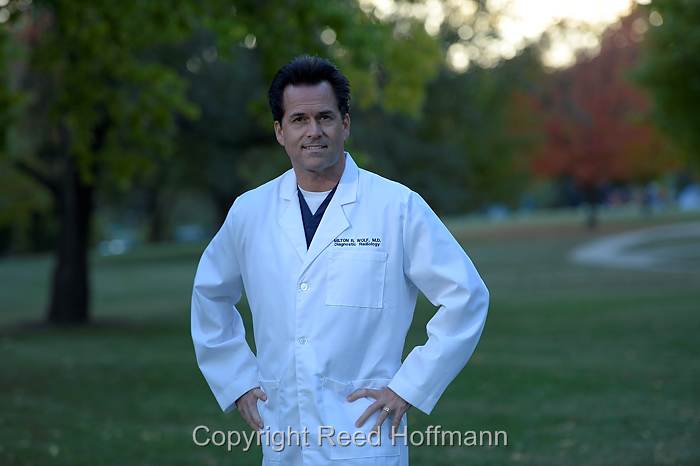
With the flash set to expose the same as the available light, you can hardly see it’s being used. Nikon D4, ISO of 400, shutter speed 1/320 at f/2.8. 70-200mm f/2.8 lens. Photo copyright Reed Hoffmann.
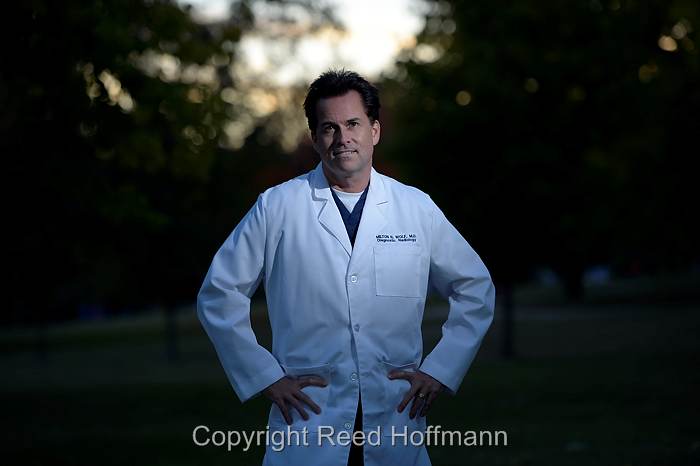
Raising the shutter speed allowed the background to go darker, and the grid on the flash created a spotlight effect. Nikon D4, ISO of 400, shutter speed 1/1000 at f/2.8, 70-200mm f/2.8 lens. Photo copyright Reed Hoffmann.
To make him stand out from the background, it was important I underexpose that background. If I simply exposed for the available light, you’d hardly see any effect from the flash. Using the Auto FP function of the camera let me shift the shutter speed above the normal flash sync of 1/250. The advantage to that is the ability to maintain a wide aperture (f/2.8) for shallow depth of field while pairing it with a high shutter to darken the background. One basic tenet of working with flash is to consider aperture and shutter speed separately. Flash exposure is primarily achieved with aperture, while shutter speed controls what happens to the available light. Put more simply, you can think of shutter as controlling background exposure and use aperture for subject exposure.
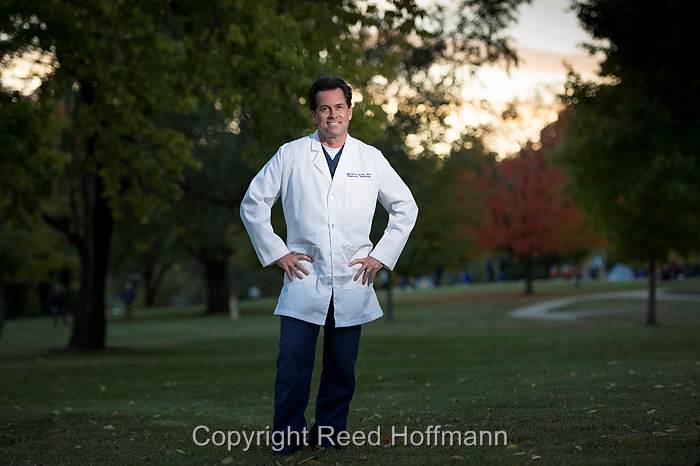
This is the image the paper chose to use with their story. Nikon D4, ISO of 400, shutter speed 1/500 at f/2.8, 70-200mm f/2.8 lens. Photo copyright Reed Hoffmann.
I finished the shoot at 6:17pm, two minutes late, but everyone was happy. I tried to shoot fast and vary both framing (wide, tight, horizontal, vertical) and exposure. From the first frame to the last was six minutes, in which time I shot 61 pictures.
Back home I downloaded the shoot (182 photos in all) and selected ten pictures that would give the paper flexibility in layout. I’d shot in RAW (NEF) format in case I had a color or exposure problem, but the photos were good as is. Making some minor adjustments in Adobe Lightroom, I then exported them as JPEGs, wrote captions and delivered the group digitally via FTP. That whole process took less than an hour.
It was nice to do a “news’ assignment again, as that’s just a small part of what I tend to shoot these days. Having to make decisions on the fly, working with whatever the conditions are and still making good pictures is a big part of photojournalism, and something I’ve always enjoyed. The key with this, as with most photography, isn’t so much the pushing of the shutter button, but the prep work that goes before. Good planning if often the difference between a good picture and a mediocre one.

